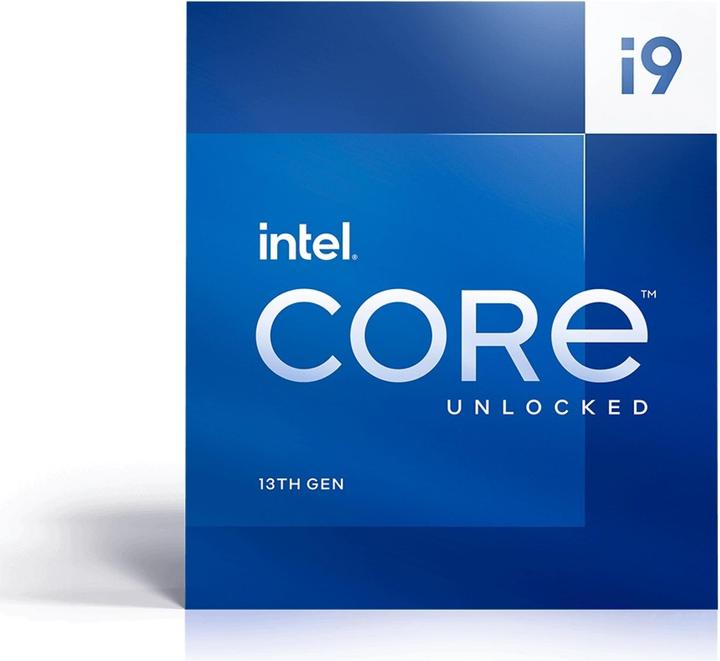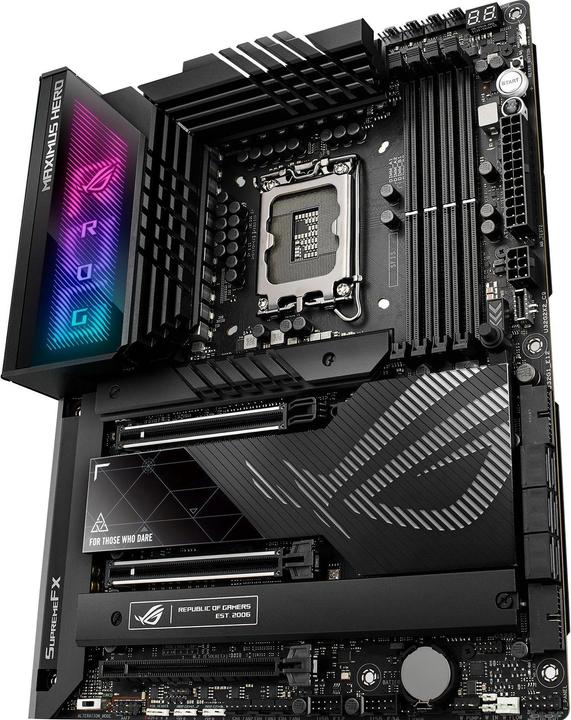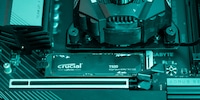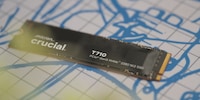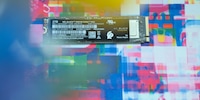

The Crucial T700 Pro SSD is crazy fast and expensive
Crucial’s latest M.2 SSD offers high speeds thanks to the PCIe 5.0 standard. However, you won’t notice much of this in everyday use. For this reason, and due to its whopping price tag, buying one probably only make sense for a few of you out there.
In theory, PCIe 5.0 enables almost double the read speed of PCIe 4.0. Current estimates go up to 14,000 MB/s (megabytes per second). However, with 12,400 MB/s, the new Crucial T700 Pro isn’t playing to its full potential. That’s still insanely fast though, as this test shows. But it also proves that you’ll hardly notice this in daily use.

Features
Crucial relies on the Phison PS5026-E26 controller for the T700 Pro, which is Phison’s first consumer-level controller for PCIe 5.0. It’s designed for up to 14,000 MB/s sequential read and 11,800 MB/s sequential write speeds. For random read and write, you’re looking at 1,500,000 and 2,000,000 IOPS (input/output operations per second). To achieve speeds exceeding 10,000 MB/s in sequential read, it needs fast 3D NAND memory with 2,400 MT/s (mega transfer per second). In other words, the actual performance also depends on the type of flash memory. Other factors for the controller to reach its potential are memory size and system configuration. If these and the terms below are all gobbledegook to you, I recommend reading the following article on how an SSD is constructed and how it works.
Crucial relies on Micron 232-layer 3D TLC NAND for the NAND memory. NAND is a non-volatile memory technology that doesn’t require power to store data. TLC stands for Triple Level Cell. This means 3 Bits are allocated per memory cell. My two-terabyte (TB) review sample has four NAND memory modules. The SSD’s warranty lasts five years or up to a set write limit. This varies depending on the SSD’s storage capacity. In the case of my 2 TB review sample, the limit is 1,200 TB of written data.
In addition to the PCIe 5.0 connection and the M.2-2280 form factor, the T700 Pro relies on the new NVMe 2.0 standard for its software protocol. This won’t change much for you. Compared to version 1.4, it’s simply a reorganisation of the protocol.
For each terabyte of memory (TB), the T700 Pro is equipped with 1 gigabyte (GB) of DRAM cache. Dynamic Random Access Memory stores the location of the data on the SSD. It’s available in 1, 2 or 4 TB capacity and with or without a heat sink. I received the 2 TB model with and without a heat sink from Crucial for testing. I tested the version without a heat sink, as I’m testing with a PCIe plug-in card.
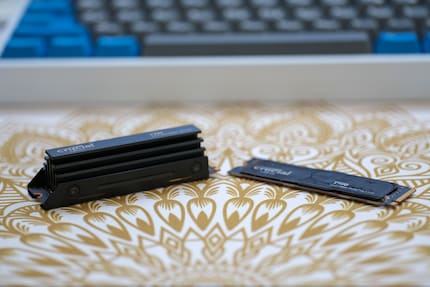
Source: Kevin Hofer
A quarter of the storage volume – that’s 500 GB in the case of my test sample – can be written with 1 bit in the fast, single-level cell mode (SLC). Once these are used up, the disk switches back to TLC mode. SSDs use a trick here. Namely, if SLC mode is exhausted and no large write operations are pending, they shovel the data into the TLC memory.
Sequential write and read speed in the ATTO Disk Benchmark
Sequentially stored data is saved in contiguous blocks. Thanks to sequential read and write, you can estimate how fast the SSD is when accessing large multimedia files, transcoding videos or watching movies. Manufacturers like to quote sequential speeds, as they offer the highest values.
I perform all tests on my test system, which has the following components:
The following chart shows the results in comparison with two PCIe 4.0 SSDs. To keep things clear and understandable, I didn’t add each individual result to the graph. You can see the maximum measured results.
With 11,560 MB/s, the T700 Plus doesn’t reach the specified maximum read speed of 12,400 MB/s. Most SSDs fail to reach the official figures in the benchmark. Measured against the other two SSDs, the difference between promised and actual performance is about the same. It doesn’t quite reach the stated write speed of 11,800 MB/s with 10,980 MB/s either. The SSD only deploys its full read and write speed from a file size of about 128 kilobytes (KB). Compared to the PCIe 4.0 SSDs, the read and write speed almost doubles.
Random access and more on sequential speed
While the MB/s and GB/s values are central for sequential read and write, the IOPS values are central for random write. The higher the IOPS values, the faster the SSD. The shorter the response times, the faster the SSD reacts. Random read and writes refer to data that isn’t stored in contiguous memory cells; they’re randomly distributed on the SSD.
For random read and write, the differences are less obvious than for sequential. Nevertheless, the T700 Pro has a decent lead over the PCIe 4.0 SSDs with a maximum of 43 per cent for writing and a maximum of 40 per cent for reading.
PCMark 10 and temperatures
The first two benchmarks test the SSD’s speed in artificially created scenarios. PCMark 10’s storage benchmark is more realistic.
The difference to both PCIe 4.0 SSDs is also relatively big in PCMark 10. The Crucial SSD is up to 79 per cent ahead in the score. The difference in access time is even greater: at 31 microseconds, it’s half that of the MP600 Pro. I know, this sounds like a lot. But whether your browser opens within one and a half instead of three seconds won’t really make much difference in your daily life. You’ll only really feel it when you’re dealing with large amounts of data.
The PCMark 10 test takes about an hour, during which the SSD is in constant use. For this reason, this benchmark provides the best opportunity to gauge the temperature. To monitor the temperature of the SSDs, I use CrystalDisk Info. The tool also gives me information about the health of the drives, the interface and the transfer mode. If you’re interested in the influence of temperature on the speed of SSDs, you can read more about it in the following article.
When idle, the T700 is 45 degrees Celsius. During the benchmark, the temperature increases to a maximum of 52 degrees Celsius. I’m surprised at how low that is. In the run-up to the launch of PCIe 5.0 SSDs, you’d always see huge heat sinks. Some of the models were even actively cooled. Therefore, I assumed that the SSDs would overheat quickly with the new standard. The fact that this isn’t the case could also be down to my setup: I’m testing on an open test bench. On top of that, my motherboard itself doesn’t support PCIe 5.0. I have to mount the SSD on the included plug-in card to benefit from the full speed. This plug-in card also acts as a huge passive heat sink. In other words, my results should be taken with a pinch of salt. Without a heat sink, the SSD quickly reaches its thermal limit and then throttles. The version with a heat sink is therefore recommended for all of you who don’t have one permanently mounted on the motherboard. If you do have one, that should be enough.
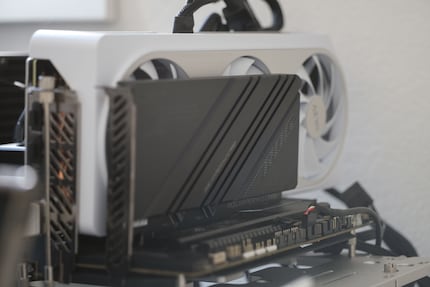
Source: Kevin Hofer
Loading times in games with 3DMark storage benchmark
If you’re an avid gamer, I’m sure long loading times bother you. The visuals show how fast the SSD is in certain game scenarios.
With games as well, it turns out the T700 Pro is almost twice as fast as a PCIe 4.0 SSD. But as already mentioned for PCMark 10, you’ll probably only notice the difference in games with long load times. Whether the game loads in five or three seconds doesn’t make much difference. However, if you’re looking at 15 instead of 28 seconds, the difference is more noticeable.
When does the T700 Pro start throttling?
Finally, I copy two uncompressed films with a total size of 69 GB from the T700 Pro onto itself, and measure how long it takes to transfer the data. This test allows me to find out whether the SSD throttles down the transfer speed after a certain amount of data.
When the SSD is almost empty, the transfer speed is 3.6 GB/s on average. It doesn’t once throttle throughout the entire transfer. It’s an excellent result. Compared to the WD SN850 or the Corsair MP600 Pro, this is more than twice as fast. The T700 Pro also impresses in my other copying tests.
I delete all data from the SSD and repeat the test with twice the amount of data, i.e. 138 GB. I repeat the latter step until the T700 Plus starts throttling. The SSD only starts throttling from around 500 GB of data to be copied. The SLC mode appears to be exhausted. From that point, the data transfer runs at 2 GB/s, which is still faster than the two PCIe 4.0 SSDs.
Once the SSD’s a quarter full, it already throttles from 3.6 GB/s to 2 GB/s after 200 GB of copied data. If it’s half full, the speed also drops after 200 GB of data. In this case, even to 1.5 GB/s. When three quarters of the SSD are full, it still manages to write 100 GB at full speed. After that, it drops from 1 to 1.5 GB/s.
During all these copying processes, the SSD never gets hotter than 58 degrees. That’s excellent. However, the same restrictions already mentioned in the paragraph about PCMark 10 benchmark apply.
Verdict: double the performance at double the price
The PCIe 5.0-based Crucial T700 Pro really makes PCIe 4.0 SSDs eat its dust. In my tests, it proved over twice as fast as the comparison SSD. Due to its sound active cooling, the solid-state disk keeps a cool head – even when copying large amounts of data. The write performance is impressive even when the memory is almost full.
But what sounds like a lot, is only noticeable to a limited extent in a home-office scenario or even when you’re gaming. The SSD is mainly worth getting if you tend to shovel extensive amounts of data back and forth or are dealing with large photo and video projects. Or if you like having the best and the fastest you can get. For everyone else, a PCIe 4.0 SSD will do the trick. Especially given the fact that it’s significantly cheaper.
The T700 Pro costs more than twice as much as the PCIe 4.0 competition. The WD Black SN850X, the faster successor of the comparison SSD used in the test, costs 169 francs/euro with the same storage size of 2 TB. The T700 Pro costs 371 francs/euros at launch (both as of 30 May 2023). Add that to the initial cost of a PCIe 5.0 capable system, and you’re looking at a big sum. In other words, it’s worth thinking carefully about whether you actually belong to the above target group.
From big data to big brother, Cyborgs to Sci-Fi. All aspects of technology and society fascinate me.

